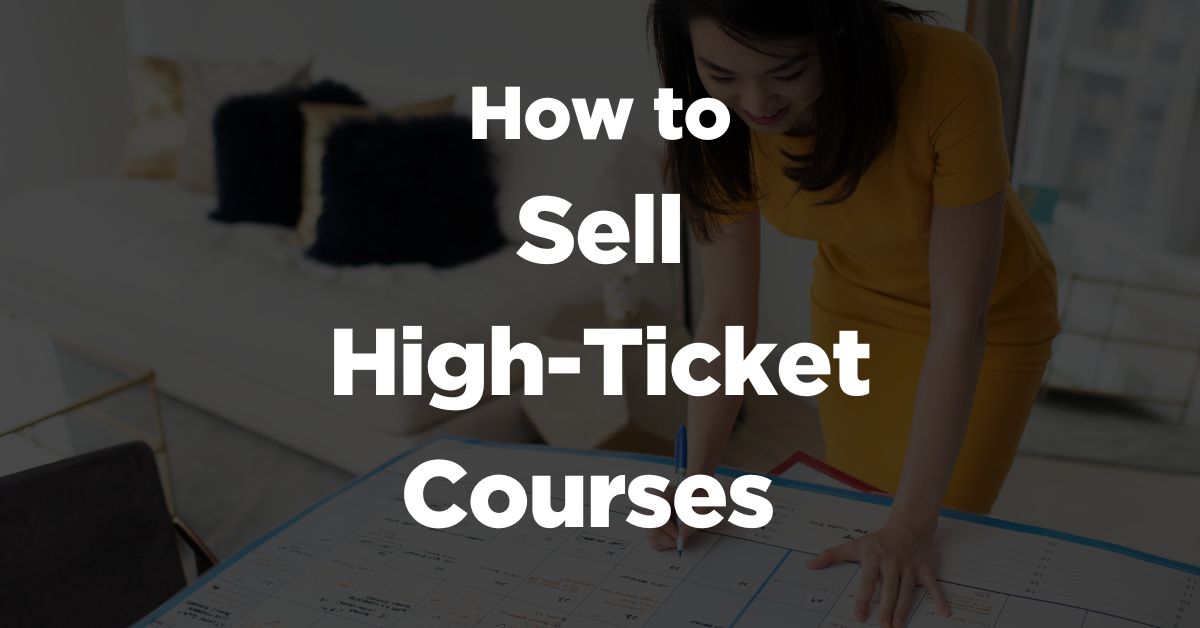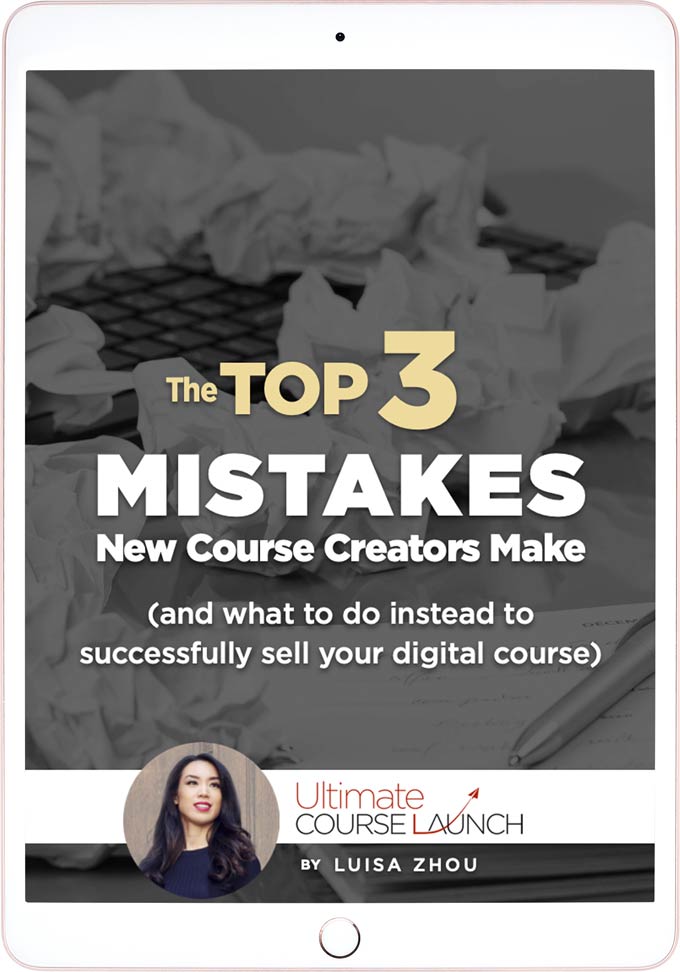Want to know how to create and sell high-ticket courses?
If you’ve been thinking about creating a high-ticket course to take your business to the next level, you’ve come to the right place. Today, you’ll learn what it takes to create and sell high-ticket courses to build your business faster.
Ready to learn more? Read on!
You’ll learn…
- What is a high-ticket course?
- How do you create a high-ticket course?
- How do you sell your courses?
- How do you launch your online course?
What is a high-ticket course?
Did you know that online courses will become an industry worth almost $500 billion by 2027? With over 98% of US corporations including online courses in their organizations, online learning is only expected to grow.
Since online learning isn’t slowing down anytime soon, it’s the perfect time to make and launch a high-ticket, online course.
But what makes a course high-ticket?
What is a high-ticket course?
A high-ticket course is an online self-study course that sells for around four figures. You’ll typically see these courses start at $900 and go up from there. Usually, they teach the A to Z of a system.
So students learn everything there is to know about getting a promotion, losing weight, or whatever it is you help them with.
Your course will include pre-recorded audio and video lessons. And sometimes, it may involve support, such as weekly or monthly coaching meetings. While personal support isn’t a prerequisite for high-ticket courses, it will significantly increase the value of your course.
So what are some of the benefits of a high-ticket course? Let’s find out next.
What are the benefits of a high-ticket course?
A high-ticket course has several benefits for you as a business owner.
First, you can scale your business (whether it’s coaching or service-based) with a high-profit product.
Just think: Once you create your course, the rest is profit. Besides some smaller costs like payment processing, everything you make goes straight to you.
And as your course is high-ticket, you turn a profit much faster than if you sell a $200 course or similar.
Here’s what I mean–as you can see, the difference between a high-ticket course and a normally priced course is significant:
10 x $1,999 = $19,990
10 x $200 = $2,000
Second, a high-ticket course gives your business plenty of freedom and flexibility. Since you’ll be giving out your expertise in a packaged format, you’ll get more time back in your day.
Third, you’re typically teaching an entire system. Once your clients finish your course, they should be equipped with what they need to succeed in their fields. And that at a significantly lower price than they would if you taught it to them personally.
But how do you create high-ticket online courses that sell? Let’s find out.
How to create a high-ticket online course
This is where the fun really starts.
Now that you’re clear on what a high-ticket online course is, let’s dive into how to create one.
And first–WHEN you should create your high-ticket course.
When is the right time to create a high-ticket course?
I see a common mistake when people start creating their first courses…
…They try to pack all the information they know into the course. Then, they get overwhelmed and never come back to finish it.
If this is your first course, I recommend starting with a “First Steps” course. This is a smaller, bite-sized course with the simplest first steps that you can teach.
Take me, for example. I didn’t start with my first high-ticket course, Employee to Entrepreneur, right away. Instead, I started with a smaller course because I knew I could launch it faster and use those learnings to create my flagship course.
So I started by creating Your First Paying Clients. This was a lower-priced offer that helped people get tangible results fast and put me on their radar as the person to help them build their coaching businesses.
Your course should help clients take the first few steps toward their goals. If you’re a productivity coach, why not make a course that tackles your clients’ morning and night routines?
Or, if you specialize in public speaking, you can help your clients give better meeting pitches instead of jumping to conference speeches.
Although this won’t be a high-ticket course (you’ll probably price it at up to $500), it will help you launch a course so much faster. You’ll also learn a lot in the process–creating this course first will help you create a better high-ticket course when you do.
That said, whether you create a first-steps or high-ticket course, you need to have strong course material.
What should your high-ticket course be about?
Let’s find out.
What should your course be about?
To start creating your course, you need to figure out what skills you already have that you can turn into a high-ticket course. If you’ve already created a course, you can base this course on that existing product.
Have you helped someone overcome a fear of public speaking? You could create a public speaking course that teaches your entire speaking methodology.
Figured out the secret to losing (and keeping) weight off? Why not offer a fitness and nutrition course to build abs in a certain amount of time, lose weight with your strategies, or run their first marathon?
Another option I recommend is first to create a group coaching program instead of a high-ticket course. Instead of meeting with clients one-on-one, you meet with a group once or twice a month.
Here’s a bit more on how to launch your group coaching program:
Your high-ticket course can also include elements of your group coaching program. For example, I included live coaching for 300-400 people per year in my first years of selling Employee to Entrepreneur. But the course itself was a self-paced, self-study course.
Learn more about creating a high-value course here:
Now that you’ve created your course, all that’s left is to sell it. We’ll talk about that next.
How to sell high-ticket courses
Once you’ve created your course, you must decide how to package it. Will you use PDF, audio, video, or a mixture of all three?
Although you should package courses smartly, what you’re teaching your students is much more important than how you teach it.
Even so, most people are willing to pay more for video content, and as you’re selling a high-ticket course, offering high-value content is key. One way to do this is by creating a slide deck that walks people through your content.
Remember, though, it’s not just about how much information is in your course. You want to create a course that helps people take action and get results.
After deciding how to package your course, it’s time to think about the price.
How to price your high-ticket courses
At what price point can you sell your online courses?
$900 – $1,000 is a good starting point for your first high-ticket course. After getting feedback and improving the content, you can always increase the price. (High-ticket courses tend to sell at up to $3,000 unless you include more personal support.)
If you want to increase your price and revenue, add in some bonuses and upsells. These bonuses can be simple, like templates or additional coaching calls.
You can even use them to get clients to purchase another course or buy future coaching offers.
Pick a platform to launch your high-ticket courses
Where can you sell your online course?
Many people choose course marketplaces like Udemy or Skillshare to sell their courses. Others use their own website.
I like to sell digital courses from my own website, using a course platform or a WordPress plugin.
Why?
The issue with course marketplaces is that they own your courses. They have a say in the pricing and visibility of your courses.
Also, you likely won’t be able to sell your high-ticket course on a marketplace like Udemy, because their pricing model is completely different. Most courses on those types of platforms sell for $10-$100.
With your website, the power is in your hands. You can decide how to price your courses and give better support to your clients.
An alternative to your own website is to use a course platform that hosts your course. Such platforms include:
- Teachable
- Thinkific
- Podia
- LearnWorlds
- Kajabi
It’s not enough to simply host your course on a platform or your website. You’ll need to market it to drive traffic to your course. Let’s find out how you can do that.
How to market your high-ticket course
There are dozens of marketing strategies out there to market your high-ticket courses, including:
- SEO
- Advertising
- Podcast pitching
- Pinterest marketing
- Youtube marketing
- Instagram marketing
- Affiliate marketing
- Client referrals
These are just a few of the marketing strategies you can use to market your high-ticket courses. Pick one to two and master them before moving on to the next.
I talk about how to pick the right marketing strategy for your business here:
You’ve got a great foundation for your courses. Now, let’s look at how to launch them.
Launch your high-ticket courses
Finally, it’s time to launch your courses. To have a successful launch, I recommend following a four-step launch system. Let’s find out what those are.
Step 1: Pre-launch
You want to drum up excitement for your new launch during the pre-launch stage. You can focus on connecting with your existing audience and work on reaching new potential clients.
During one of my first launches, I reached out to my audience through webinars and live streaming. I also trained my audience from the beginning to know that my paid offers were a lot more valuable than my free ones (in a non-salesy way, of course).
My efforts paid off. My first launch brought in $8K, and my second, over $100K.
In this short video, I talk more about my first launch:
Building your audience is one of the best ways to get hundreds of eyes on your product before you even launch.
Step 2: Launch trigger
Now that you’ve built your audience and they know about your launch, it’s time to introduce your launch trigger.
This event generally builds up to the launch of your high-ticket course.
One past strategy that’s worked for me is holding a live challenge. A live challenge is a short live event or competition you hold to attract clients. This challenge leads up to your course, and it’s created to give clients a taste of what they can expect from your course.
The most successful challenges give clients a small result and help you connect further with your audience.
When people see how your course has changed people for the better, they’ll be much more likely to buy it.
Overall, your launch trigger should help clients understand what the course can do for them. Once they see real results, you’ll have people lining up on launch day.
Step 3: Launch
The third step is to launch your course.
Announce that your course is available for enrollment for a few weeks. During your enrollment period, promote your course to your audience as much as you can.
Talk about your course with past and present students, interact with them in Facebook groups, and send out promotional emails.
Step 4: Post-launch
After your launch, you can focus on supporting your new course students. You’ll also want to look into your course statistics and testimonials to see what’s working and what you need to change.
During my first few launches, I created private Facebook groups to connect with students. I gave personalized email support and replied to every email I got.
Because I kept offering support to my students, they got great results. Many of them have gone on to create and launch their own high-ticket courses following the same methods.
Once you’ve launched your course, you can work on making it evergreen. How? That’s what we’ll talk about next.
Go evergreen!
When you have a system in place for launching your course, you’ll want to make it part of an evergreen sales funnel. An evergreen high-ticket course is one that basically sells itself.
You make a course evergreen by automating your sales funnel, so it does the work for you of connecting with ideal clients and selling your course.
An evergreen sales funnel consists of three things:
- Course
- Traffic source
- Sales system
Since you’ve already set up and launched your course, you need to focus on building traffic.
So how can you direct traffic to your course?
I like to drive traffic from several sources:
- Facebook and Youtube Ads
- Youtube
- SEO (search engines)
- Guest Posts
- Podcasts
- Affiliates
If you don’t have any traffic heading to your course now, don’t worry! I recommend picking one traffic source and building it up before moving to the next one.
Over to you!
There you have it! Now you know how to create high-ticket courses to sell. While building a successful high-ticket course won’t happen overnight, you can build and sell high-ticket courses that help you move toward financial freedom.
I’ve helped hundreds of people create their own courses. And what I see over and over is that most new course creators make a few mistakes that hold them back from creating a truly impactful course that sells.
Want to know what they are?
Get my free PDF that shows you these 3 mistakes – and how YOU can avoid them.








